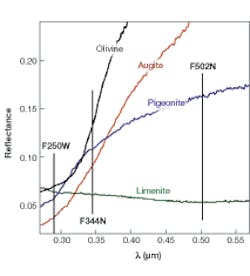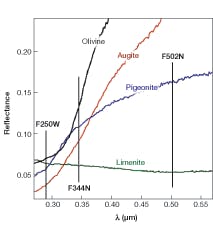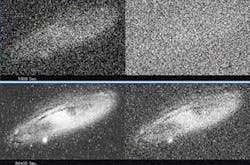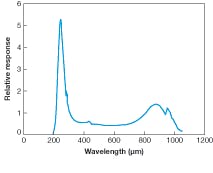UV DETECTORS: GaN-based detectors advance UV astronomy
Gallium nitride can be used to make efficient, solar-blind UV detectors suitable for applications in astronomy and environmental sensing that require high sensitivity in the UV and low sensitivity in the visible.
MELVILLE P. ULMER AND BRUCE W. WESSELS
Ultraviolet astronomy is one of the fields that accelerated after the creation of the National Aeronautics and Space Administration (NASA; Washington, D.C.) and when telescopes could be placed above the Earth’s UV-absorbing atmosphere. Since then, UV astronomy has played a key role in our understanding of the universe, from some of the most distant stellar and galactic objects to more familiar objects in our own solar system.
To assist with improving UV science, researchers are developing new detection technologies such as gallium nitride (GaN) photocathodes for UV astronomy. These devices detect the resonant absorption lines of the majority of the elements-carbon, nitrogen, and oxygen-that are only detectable in the UV. Astronomers use these measurements to follow chemical evolution of galaxies over the last 10 billion years, the estimated age of the universe. It is these chemicals that eventually formed planets and life (at least once) in our galaxy.
UV astronomy
Measuring the UV spectrum can allow us to understand the variety of shapes in Hubble Space Telescope near-infrared (near-IR) images of very distant galaxies. The galaxies are so distant that the near-IR light we detect corresponds to UV light that the galaxies are emitting. These distant galaxies often appear clumpy and unusual in comparison to nearby galaxies seen in the optical or near-IR. However, a comparison with UV images shows that at least some nearby galaxies also appear clumpy in the UV. As a result, these very distant galaxies, which were originally hypothesized to be galaxies in formation, may be more mature than some had originally speculated.
The UV region also allows us to learn about the era of reionization of the universe (about 0.3 to 2 gigayears after the big bang)-a time when strong sources of UV ionized the intergalactic medium. Absorption features that we can detect in the UV caused by singly ionized helium whose features are red-shifted into the UV (He II) give astronomers specific insights about the yet-to-be-determined sources of the ionization. However, improvements in sensitivity are needed to expand the current knowledge in this field.
In our own galaxy
In addition to observations of extragalactic and cosmological import, the UV can be used to study phenomena in our own galaxy on a variety of size scales. Just one example is the UV imaging spectroscopy of absorption and emission lines that show how the metals are distributed in planetary disks and jets. The distribution of metals (anything heavier than He for an astronomer) in stellar disks gives us important clues to planetary formation, because the existence of metals seems to be necessary for all planet formation. And we speculate this is especially so for Earth-like rocky planets.
Even closer to home, UV missions can contribute to an understanding of phenomena within our own solar system. For example, UV images have revealed the aurora of Jupiter caused by a radiation belt that is much more intense than the Earth’s own Van Allen Belts.
Resource mapping on the Moon-to better understand the Moon’s history and formation within the solar system-also requires knowledge of the UV spectrum. For example, the reflectivity of ilmenite (a high-oxygen-content material) can be singled out from other common lunar crust materials by broadband reflectivity ratios in the UV to near-IR spectrum (see Fig. 1).
New UV detectors needed
An ideal next step beyond the Hubble Space Telescope (HST) for a UV-visible mission would be to scale up the HST (to 4 m vs. the current 2.4 m diameter) with an upgraded UV detector replacement for the HST Imaging Spectrometer (STIS) that is about 10% quantum efficient in the UV. This brings us to why we have wanted to develop new detectors: in reflection mode, 70% quantum efficiency (QE) has been achieved and in transmission mode, 40% to 60% QE has been reported.1, 2 So the next improvement over STIS in the best-case scenario with a transmission-mode system would be (4/2.4 × 4/2.4) × 5, which is equal to about 14 times, such that this new mission would give in 100 orbits the equivalent of 1400 HST orbits, as well as having the potential to improve the angular resolution by a factor of 4/2.4.
Although improved UV quantum efficiency is quite important, CCDs have nearly 40% QE in the UV (using the HST Advanced Camera for Surveys High Resolution Camera), which begs the question of why someone would want to develop GaN photocathodes? There are at least two reasons. First, CCDs are not (yet) zero-read-noise devices, which are necessary for optimal low-light-level long exposures (hence the existence of STIS on the Hubble Space Telescope). This is demonstrated in simulations generated by Don Lindler of Sigma Space (Potomac, MD) and provided by Bruce Woodgate of NASA Goddard Space Flight Center (see Fig. 2). Even though the simulations assumed a QE disadvantage for the zero-read-noise detector, zero read noise provides a much better signal-to-noise ratio (SNR) than a higher-QE detector with finite read noise, for both moderate and long observing times.
The second reason is that even with a very good filter (the HST F220W), a very good mirror (the HST), and a CCD (the HST Advanced Camera for Surveys High Resolution Camera), there is a significant red leak for the images obtained with this system. Taking a conservative case of a 3000 K blackbody, the peak response is shifted to the red due to the steeply falling blackbody spectrum on the blue side (see Fig. 3). The red leak is also significant for objects in which interstellar dust makes the objects appear even redder than they are naturally (which is a typical phenomenon in astronomical applications, and also explains why sunsets look red).
GaN detector progress
A high-QE photocathode, such as those made from GaN, addresses the SNR issue and the bandgap of 3.4 eV makes the GaN-based devices effectively visible blind, simultaneously preventing red leak. But growing good GaN that can be converted into a photocathode through cessiation-a process of coating the detector surface with a 1-nm-thick n-type layer of metallic cesium-is not that easy. The GaN must be highly conductive and p-type to be made into an effective photocathode. Our group at Northwestern University (Evanston, IL) grows GaN via metal-organic vapor-phase epitaxy (MOVPE) to yield material with low defect concentrations.3 Low defect levels are crucial for high electron mobility and to produce visible blindness.
The electron mobility is especially important for transmission-mode photocathodes in which the photoelectron must travel on average farther than in the reflection or opaque mode. Making the material p-type with a relatively high carrier concentration of up to a few times 1017/cc is required for optimal photocathode performance. Although this concentration is difficult, it has been accomplished. Ideally, the GaN would be grown directly on a microchannel plate, and then an opaque-mode zero-read-noise detector would be in hand.
However, highly conductive p-type GaN has not yet been grown successfully on any microchannel-plate surface. The most promising microchannel plate to use is one made of silicon (Si) that can withstand the heat needed to grow (by MOVPE, but molecular-beam epitaxy works at lower temperatures) and to clean the GaN in preparation for cessiating it to convert it into a photocathode. One main problem is that Si (or Si carbide as the surface layer of the MCPs) does not give a good epitaxial match to the GaN. Until growing good GaN on a microchannel plate can be accomplished, the alternative is to grow GaN on sapphire and either put the photocathode in a reflection-mode electron-bombardment CCD (EBCCD) or a transmission-mode EBCCD. The latter has the advantage of being able to insert an MCP between the photocathode and the CCD, such that gains of 15,000 can be obtained and a zero-read-noise device can effectively be made.
The reflection mode has the advantage of being able to use a magnesium fluoride window that allows the device to work down to 110 nm (versus about 150 nm for sapphire) and gains can be made high enough (3000) to be zero-read-noise devices. In space, the reflection-mode device could even be made windowless and allow measurements to even shorter wavelengths than 110 nm.
In the near term, however, it would appear that transmission-mode GaN is the simplest path to follow to make a compact (3 cm diameter by 5 cm length), lightweight (less than 100 g without the electronics) imaging device. We anticipate, in a few years, seeing GaN-based cameras available for use in space for astronomy purposes and in ground-based applications such as environmental monitoring and flame detection.
REFERENCES
1. O.H.W. Siegmund et al., Proc. SPIE 5164, 134 (2003).
2. S. Uchiyama et al., Applied Physics Lett. 86, 103511 (2005).
3. M.P. Ulmer, Proc. SPIE 6189, 24 (2006).
MELVILLE P. ULMER is a professor in the Department of Physics and Astronomy and BRUCE W. WESSELS is a professor in the Department of Electrical Engineering and Computer Science and Materials Science and Engineering at Northwestern University, 2131 Tech Drive, Evanston, IL 60208-2900; e-mail: [email protected]; www.astro.northwestern.edu/~ulmer.



